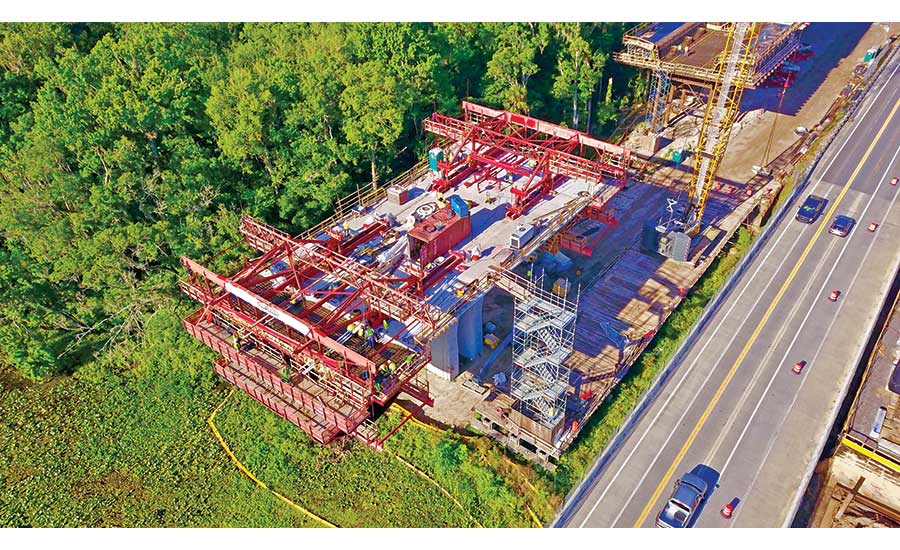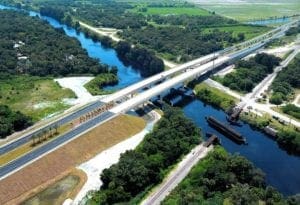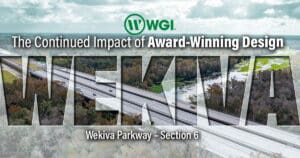
2021 ENR Top 500 Design Firms List: WGI Moves Up to #175
WGI moves up 12 spots on the Engineering News-Record (ENR) 2021 Top 500 Design Firms List!
Learn from award-winning professionals — explore our whitepapers, blogs, and the latest industry updates.
Join our dynamic organization of engineers, land surveyors, landscape architects, environmental scientists, and architects!
Talk to a market leader today! We’ll answer any questions you have about our professional services.

By Scott Judy – Deputy Editor, ENR Southeast (read original article)
Contractors building a key stretch of the $1.6-billion Wekiva Parkway project are finding success executing their planned river crossing while at the same battling head-scratching underground issues. So far, project leaders with Superior Construction Co. Southeast say crews are on plan and on schedule with their $234.5-million Wekiva Parkway Section 6 contract. The 6.1-mile-long section includes construction of a new parkway, three segmental bridges for the Wekiva crossing, six conventional bridges and nine wildlife crossings.
In all, the entire Wekiva Parkway project measures approximately 25 miles from end to end. After starting work in late June 2017, construction is now roughly 45% complete, with final completion eyed for the end of March 2021, says Jhon Beltran, project manager with Superior Construction.

During the Wekiva Parkway’s years-long planning process well before the start of construction, the river crossing had been a justifiable focus of environmentalists. Deemed a “wild” and “scenic” river by the federal government, the Wekiva is essentially a primitive river that exists in its natural state, free of any impoundments.
“It’s a project that a lot of people have had exposure to over the years,” Pete Kelley, president with Superior Construction, told ENR Southeast last year: “It definitely has a lot of eyes watching it.”
Adds Beltran: “When you see how beautiful [the river] is, it gives you a different sense of responsibility.”
The Wekiva River bridge—designed by Finley Engineering Group, Tallahassee—is comprised of three separate structures, a move made partly to minimize river impacts. Two of the three 360-ft-long river spans will accommodate eastbound and westbound traffic along SR 46, while the third provides a local service road and allows for pedestrian traffic.
Superior’s phasing calls for constructing the service road first, followed by the westbound bridge next to it, and then the eastbound structure. Notably, despite the close proximity of the construction to the relatively narrow Wekiva, the river is remaining mostly accessible to the public for canoeing or other activities.
Due to the fact that the river must stay as untouched as possible, contractors couldn’t opt for any bridge construction methods requiring barge work. Instead, Superior and its design-build partner WGI are using cast-in-place segmental construction to build the three bridges. Relatively unusual in Florida compared with precast segmental erection, the method has come with a learning curve.
Overseeing this work is Juan Rivera, segmental superintendent, who formerly worked for PCL Construction, where he had worked on other cast-in-place segmental projects in other states, including Georgia. Due to the relative rarity of cast-in-place segmental bridge erection, Rivera says the crew has been slowly picking up the pace since starting work about seven months ago.
Rivera added: “It’s not easy. We still have some glitches here and there.”
As of early April, the crew was completing four segments on an approximately eight-day cycle, Rivera says, with the goal being to shave two days off of that cycle. Crews were still on their way to crossing the river at that time.
“We’re trying to gain on that,” he says.”
Before going up and over the Wekiva, though, the Superior-WGI team had to plan carefully how crews would construct waterline footings so as to minimize environmental impacts. The contractor installed two levels of floating turbidity barriers and also contained footings excavation within steel sheet-pile cofferdams.
The contractor further plans to pump any discharge from dewatering activities at the footings into a sediment filter box. To further reduce the likelihood of construction material making its way into the river—from a rain event, for instance—contractors hauled away all excavated material rather than stockpiling it on site.
The majority of Superior’s 6.1-mile-long section traverses across land, though much of it is elevated so as to enable the area’s varied wildlife population—including bears—to be able to travel underneath the parkway. The new wildlife crossings will measure as much as 2,000 ft in width, making for a vast upgrade over the existing crossings, which were sometimes just dozens of feet wide.
While the construction of the river spans has progressed relatively issue-free to date, the construction of these other elevated structures has proven more problematic in spots.
Currently, Superior and WGI are dealing with three areas where sinkholes have unexpectedly opened up near the precast concrete piles supporting the elevated roadway.
Considering the width of the wildlife crossings, and the area’s sinkhole-prone geography, “Our chances for hitting some unknown conditions was going to be ripe,” says Bill Scott, project manager for WGI.
At one location, the design-build team is on its third iteration—and roughly seventh month—of trying to implement a design solution. Here, for a lone pile on the northernmost end of the series, contractors couldn’t find sufficient bearing capacity, where just about 20 ft south they’d been able to do so.
“It dropped off 180 feet, like an underground cliff,” Scott says. The team tried driving a pipe pile, but drove 300 ft before giving up on that approach, he adds.
The current proposed solution involves driving two additional piles next to the nearest pile south of the problem area and “basically cantilevering the foundation out over the top of this soft soil condition,” he says.
Of this approach, Scott adds: “We’re very confident.”
Beltran, the Superior project manager, notes that the use of precast concrete caps for the elevated sections accommodating the wildlife crossings has enabled work on the other unaffected sections to be about six months ahead of schedule.

WGI is a national design and professional services firm leading in technology-based solutions for the construction of public infrastructure and real estate development. At WGI, we’re providing Tomorrow’s Infrastructure Solutions Today.

WGI moves up 12 spots on the Engineering News-Record (ENR) 2021 Top 500 Design Firms List!

Aligning responsibilities and risk by joining the forces that depend so heavily upon each other, benefits all parties – especially the taxpayer.

Taking the industry by storm and earning not 1, not 2… but 6 awards, the Wekiva Section 6 corridor between Lake County and Seminole County, FL carried WGI’s transportation team to a victorious year!

WGI places top five for the fourth consecutive year on the South Florida Business Journal Top 25 Engineering Firms List.

YES Week is about celebrating all associates by honoring their efforts, passion and devotion towards WGI’s continued success.

An e-commerce revolution has rapidly increased delivery activity. Flexible Design provides the framework for anticipating disruptive trends & impacts.
You’ve been searching for a place like WGI. We look forward to meeting you soon.
Sign up to receive emails to hear our latest news and achievements in our monthly newsletter.
Enter your zip code, and we’ll personalize your experience with local projects, office locations, team members, and more.
WGI supports its associates with meaningful opportunities for growth, strong benefits and perks, while we work collaboratively with clients and co-consultants to shape and improve communities.






WGI is a dynamic organization with opportunities nationwide for engineers, land surveyors, landscape architects, environmental scientists, and architects.